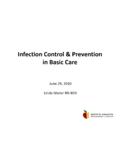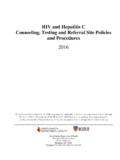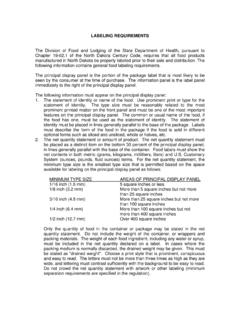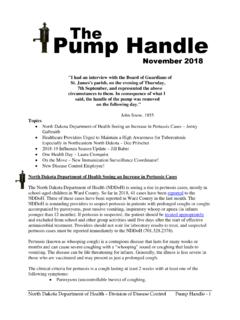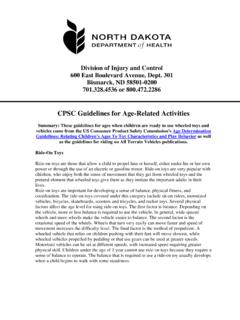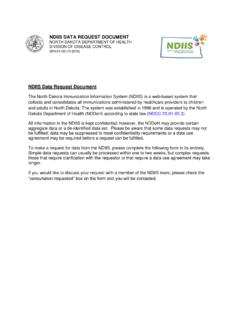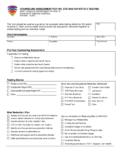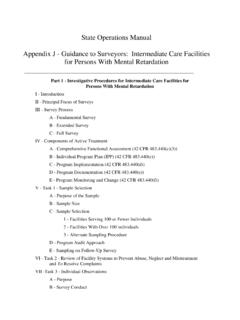Transcription of Policy Scan for Cancer Prevention Strategy
1 NORTH DAKOTA. DEPARTMENT OF. HEALTH. Policy scan for Cancer Prevention Strategy Overview of State Legislation Impacting Cancer Risk Factors, Treatment, and Outcomes Policy scan for Cancer Prevention Strategy 1. Acknowledgements: Jack Dalrymple, Governor of North Dakota Dr. Terry Dwelle, State Health Officer Susan Mormann, Director of the Division of Cancer Prevention and Control This report is a product of the North Dakota Comprehensive Cancer Control Program (NDCCCP) under the North Dakota Department of Health, Division of Cancer Prevention and Control. The NDCCCP is funded by a cooperative agreement from the Centers for Disease Control and Prevention , Cancer Prevention and Control Programs for State, Territorial and Tribal Organizations.
2 This publication was prepared by: Division of Cancer Prevention and Control Community Health Section North Dakota Department of Health 600 E. Boulevard Ave., Dept. 301. Bismarck, ND 58505-0200. Telephone: Fax: This publication was supported by Cooperative Agreement Number 5U58/DP000831 from the Centers for Disease Control and Prevention . Its contents are solely the responsibility of the authors and do not necessarily represent the official views of the Centers for Disease Control and Prevention . Authors: Milan Vu, BS, CDC Public Health Associate Janna Pastir, MPH, Program Director Copyright information: All material in this report is in the public domain and may be reproduced or copied without permission; citation as to source, however, is appreciated.
3 This publication is available online at the North Dakota Comprehensive Cancer Control Program website: Published September 2016. Policy scan for Cancer Prevention Strategy 2. INTRODUCTION. The North Dakota Comprehensive Cancer Control Public health programs should routinely conduct Policy Program (NDCCCP) is housed within the Community scans to understand the current Policy climate. This Health Section of the North Dakota Department of Health activity enables proper resource allocation, data-informed and strives to reduce the incidence and impact of Cancer decision making, utilization-focused evaluation, and for all North Dakotans by: selection of strategies that positively impact the health of *Reducing Cancer risk a community.
4 *Finding cancers earlier *Improving Cancer treatments The Policy scan for Cancer Prevention Strategy . *Increasing the number of people who survive identifies and reports North Dakota statewide policies Cancer pertinent to priorities of the North Dakota Cancer Plan. *Improving quality of life for Cancer survivors. The policies highlighted in this report represent a snapshot of enacted state-level actions affecting topics The NDCCCP, along with the North Dakota Cancer related to Cancer that can be linked to objectives and Coalition, develops and implements the North Dakota actionable strategies highlighted in the Cancer Plan. In Cancer Control Plan, a collection of priorities, objectives, addition, the scan serves to: and strategies relating to Cancer Prevention , detection, treatment, and survivorship care.
5 The plan serves as a Establish a baseline for Cancer -relevant legislation guide for collaborative action towards addressing the in North Dakota by assessing policies at the state level. impact of Cancer and is built upon based on progresses made and lessons learned from past versions of the plan. Track the health impact of Cancer -relevant legislation The North Dakota Cancer Control Plan has succeeded in over time following each Legislative Session. engaging discussion among key stakeholders and resulted in implementation of objectives and strategies Facilitate identification of Policy successes and/or areas surrounding key health issues, such as high-quality care of need within state and local-level Policy efforts.
6 Options and improved knowledge about Cancer Prevention and control. Support and inform the development of Policy , systems, and environmental (PSE) changes to address potential areas of need and to improve health outcomes for all North Dakotans. Policy scan for Cancer Prevention Strategy 3. A CASE AGAINST Cancer . Half of all men and one-third of all women in the will develop Cancer in their lifetime. North Dakota is no exception to this statistic, with Cancer sitting as the state's second leading cause of death. Cancer is a disease that brings physical, emotional, and financial challenges with it and its burden is growing. What is Cancer ? The Burden of Cancer Cancer is not a single disease, but a collection of related A Cancer diagnosis is a life changing event for every diseases defined by the uncontrolled growth and spread patient, family member, friend, and care-taker.
7 Cancer of cells into surrounding tissue. Cancer cells can spread to patients and survivors face a host of short and long-term other parts of the body through the blood and lymph challenges that can ultimately impact their quality of life. systems, which may lead to death if not controlled. Cancer Priorities Although people of all ages are diagnosed with Cancer , it While the NDCCCP and North Dakota Cancer Coalition aim is primarily an older person's disease. Over three-quarters to reduce the burden of Cancer for all North Dakotans, of all cancers are diagnosed in men and women ages 55 the program has identified seven different cancers as and older. Taking steps to prevent Cancer , however, can priorities for action.
8 These cancers have been given start at any age. priority based on several factors including incidence, mortality, ability to screen, and controllable risk factors. Risk Factors for Cancer Research shows that certain risk factors may increase the The seven priority cancers are: chance that a person will develop Cancer . *Breast Cancer *Melanoma The most common risk factors include: *Cervical Cancer *Oral-pharyngeal Cancer *Age *Family history of Cancer *Colorectal Cancer *Prostate Cancer *Tobacco *Lack of physical activity *Lung Cancer *Alcohol *Sunlight/UV exposure *Diet *Some viruses and bacteria Policy scan for Cancer Prevention Strategy 4. Policy , SYSTEMS, and ENVIRONMENTAL (PSE).
9 CHANGE. In addressing public health issues in communities, interventions historically relied on the idea that informed individuals would make the right choices regarding their health. As a result, public health efforts focused on changing personal behavior through educational programs and events. However, it has become more apparent now that factors beyond personal choice impact peoples' health and may affect health problems that cannot be solved by individual actions alone. PSE Change Policies, systems, and environments all play a role in shaping the background of people's lives; they are the laws we abide by, the worksites we function in, the hospitals we visit, and the public spaces we live in.
10 They determine the types of food a student can pick from at lunchtime, the public amenities available in a neighborhood, the interactions a patient goes through within a health care system, and much more. Compared to efforts that focus on changing individual behaviors, Policy , systems, and environmental (PSE) changes focus on modifying environmental factors in order to make healthy choices easy and accessible for all. By tackling health problems at the population level, and addressing them in an ongoing, long term, and sustainable manner, PSE changes can lead to more widespread impacts to prevent disease and improve health outcomes. Policy scan for Cancer Prevention Strategy 5.
